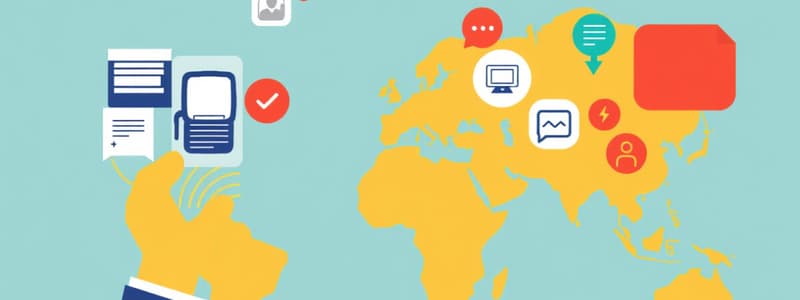Podcast
Questions and Answers
What is a key benefit of developing critical thinking skills in relation to media messages?
What is a key benefit of developing critical thinking skills in relation to media messages?
- It encourages emotional responses to information.
- It reduces the need for evaluating content.
- It enhances understanding of media messages. (correct)
- It ensures immediate acceptance of all sources.
Which aspect of information evaluation focuses on identifying any potential biases?
Which aspect of information evaluation focuses on identifying any potential biases?
- Relevance
- Accuracy
- Credibility
- Bias (correct)
Which of the following is NOT a component of media and information literacy?
Which of the following is NOT a component of media and information literacy?
- Media Literacy
- Interpersonal Skills (correct)
- Information Literacy
- Content Creation
What is a primary characteristic of traditional media?
What is a primary characteristic of traditional media?
How does the shift from traditional to new media primarily affect audience engagement?
How does the shift from traditional to new media primarily affect audience engagement?
What is one advantage of information literacy?
What is one advantage of information literacy?
What is a disadvantage associated with the abundance of information available today?
What is a disadvantage associated with the abundance of information available today?
Which of the following is an example of new media?
Which of the following is an example of new media?
Study Notes
Media and Information Literacy
Critical Thinking
- Definition: The ability to analyze, evaluate, and synthesize information effectively.
- Importance:
- Enhances understanding of media messages.
- Encourages questioning of sources and content.
- Promotes informed decision-making.
Information Evaluation
- Key Aspects:
- Credibility: Assessing the reliability of the source.
- Accuracy: Verifying facts and data presented.
- Bias: Identifying any potential partiality in the information.
- Relevance: Ensuring the information is applicable to the topic at hand.
- Techniques:
- Cross-checking facts with multiple sources.
- Analyzing the author's qualifications and expertise.
Introduction to Media and Literacy
- Definition: The ability to access, analyze, evaluate, and create media in various forms.
- Components:
- Media Literacy: Understanding different media formats and their purposes.
- Information Literacy: Skills to locate, evaluate, and use information effectively.
- Goal: Empower individuals to navigate the media landscape critically.
The Evolution of Traditional to New Media
- Traditional Media:
- Characteristics: One-way communication, fixed formats (print, radio, television).
- Example: Newspapers, magazines, broadcast news.
- New Media:
- Characteristics: Interactive, user-generated content, diverse formats (blogs, social media).
- Example: Websites, podcasts, streaming platforms.
- Impact of Transition:
- Increased access to information.
- Shift in how audiences engage and interact with content.
Information Literacy
- Definition: The ability to identify, locate, evaluate, and effectively use information.
- Importance:
- Essential for academic success and lifelong learning.
- Helps individuals discern credible sources from misinformation.
- Advantages:
- Better decision-making based on reliable information.
- Increased efficiency in research and information retrieval.
- Disadvantages:
- Overwhelm from the volume of available information.
- Difficulty in distinguishing credible sources in a vast media landscape.
Types of Media
-
Print Media
- Newspapers, magazines, journals.
- Provides in-depth analysis and traditional journalism.
-
Broadcast Media
- Television and radio.
- Offers immediate news coverage and entertainment.
-
Digital Media
- Websites, social media, blogs, podcasts.
- Facilitates interactive engagement and rapid dissemination of information.
-
Multimedia
- Combines text, audio, images, and video.
- Engages audiences through diverse formats and storytelling techniques.
Critical Thinking
- Critical thinking is the ability to analyze, evaluate, and synthesize information effectively.
- Enhances understanding of media messages and their implications.
- Encourages questioning of sources and content to foster skeptical evaluation.
- Promotes informed decision-making in various contexts.
Information Evaluation
- Credibility involves assessing the reliability of information sources.
- Accuracy requires verification of facts and data to confirm their truthfulness.
- Bias helps identify any partiality or slant in the presented information.
- Relevance ensures that information is pertinent to the topic currently under consideration.
- Techniques for effective evaluation include cross-checking facts with multiple sources and analyzing an author’s qualifications and expertise.
Introduction to Media and Literacy
- Media literacy encompasses the ability to access, analyze, evaluate, and create media.
- Information literacy refers to skills necessary for locating, evaluating, and effectively utilizing information.
- The overarching goal of media and information literacy is to empower individuals to navigate the complex media landscape critically.
The Evolution of Traditional to New Media
- Traditional media is characterized by one-way communication and fixed formats, such as print, radio, and television.
- Examples of traditional media include newspapers, magazines, and broadcast news services.
- New media features interactivity, user-generated content, and diverse formats such as blogs and social media platforms.
- Examples of new media encompass websites, podcasts, and streaming services.
- The transition from traditional to new media has increased access to information and transformed audience engagement with content.
Information Literacy
- Information literacy is the ability to identify, locate, evaluate, and effectively utilize information.
- Essential for academic success and fosters lifelong learning skills.
- Aids individuals in discerning credible sources amidst misinformation.
- Advantages include improved decision-making based on reliable information and enhanced efficiency in research.
- Disadvantages involve feeling overwhelmed by the sheer volume of available information and challenges in differentiating credible sources within a vast media landscape.
Types of Media
- Print Media: Includes newspapers, magazines, and journals; known for in-depth analysis and traditional journalism.
- Broadcast Media: Comprises television and radio, providing immediate news coverage and diverse entertainment options.
- Digital Media: Encompasses websites, social media, blogs, and podcasts, allowing for interactive engagement and rapid information dissemination.
- Multimedia: Integrates text, audio, images, and video; engages audiences through various formats and storytelling techniques.
Studying That Suits You
Use AI to generate personalized quizzes and flashcards to suit your learning preferences.
Description
Test your understanding of media and information literacy concepts. This quiz covers critical thinking, information evaluation, and the importance of analyzing media messages. Enhance your skills in assessing credibility, accuracy, bias, and relevance.




